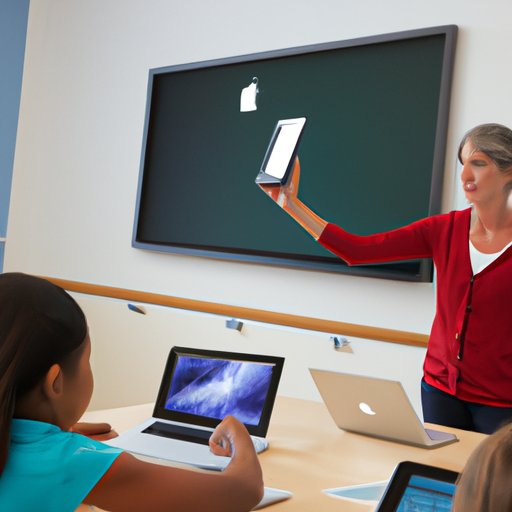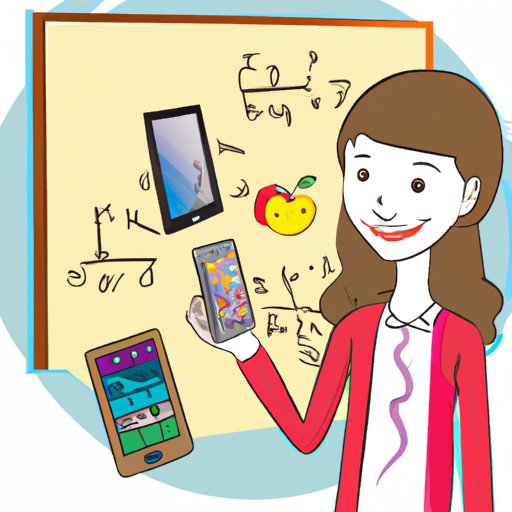Introduction
In today’s world, technology is ubiquitous and essential for success. In the classroom, technology can provide students with new and innovative ways to learn, engage with material, and collaborate with their peers. As educators continue to explore how technology can be used to enhance teaching and learning, it is important to understand the potential benefits and challenges associated with its use.
Exploring the Benefits of Online Learning Platforms
Online learning platforms such as Khan Academy, Coursera, and edX are becoming increasingly popular among educators and students alike. These platforms offer a wide range of educational resources, from videos and tutorials to interactive quizzes and games. They provide students with more flexibility to access materials at any time and from anywhere, which can be especially beneficial for those who are unable to attend traditional classes due to work or other commitments.
Research has shown that online learning platforms can also increase student engagement and motivation. According to a study by the Harvard Graduate School of Education, “students who participated in online learning activities reported an increased sense of motivation, enjoyment, and interest in their studies.” This increased engagement can lead to improved academic performance.
In addition, these platforms allow for enhanced collaboration between students and instructors. Through discussion boards, live chats, and other interactive features, students and teachers can communicate and share ideas more easily. As a result, students are able to receive feedback in real-time and instructors can quickly identify areas where additional support may be needed.

Leveraging Technology to Create Engaging Classroom Experiences
Technology can also be used to create engaging experiences in the classroom. For example, teachers can utilize multimedia tools such as video, audio, and animation to make lessons more interesting and engaging. This can help to make better use of class time and keep students focused on the material being presented. Additionally, some platforms offer virtual reality experiences that can transport students to different places and times, allowing them to gain a deeper understanding of the topics being discussed.
Games and simulations can also be used to help students learn and apply concepts in a fun and meaningful way. Educational video games, for instance, can challenge students to think critically and problem solve in order to advance through levels. Simulations can be used to teach students about complex systems, processes, and scenarios in a safe environment. By leveraging technology in this way, teachers can create unique and memorable learning experiences for their students.
Showcasing Examples of Technology-Enhanced Instructional Strategies
In recent years, several instructional strategies have emerged that incorporate technology into the learning process. Flipped classrooms, for example, utilize online videos and other materials for homework assignments, allowing teachers to use class time for more hands-on activities and discussions. Blended learning combines online and offline elements, such as lectures and labs, to give students more control over their learning. And project-based learning allows students to explore real-world problems and find solutions through research, experimentation, and collaboration.
These instructional strategies can help to create more meaningful learning experiences for students. According to a study conducted by Stanford University, “the use of technology-enhanced instructional strategies has been found to improve student engagement and performance, as well as enhance critical thinking, creativity, and collaboration.”

Discussing the Impact of Mobile Devices on Education
Mobile devices such as smartphones and tablets are becoming increasingly prevalent in the classroom. These devices can be used to access educational resources, take notes, and even participate in online discussions. They can also be used to record and share lectures, allowing students to review material at their own pace.
Mobile devices can also help to make learning more portable. Students can now access course materials and complete assignments at any time, from any place. This increased flexibility can help to reduce stress and create a more positive learning environment. Furthermore, mobile devices can help to increase connectivity between students and instructors, enabling them to communicate more easily.

Examining the Use of Artificial Intelligence in Education
Artificial intelligence (AI) is another area where technology is being utilized to enhance teaching and learning. AI can automate grading processes, allowing instructors to spend less time grading and more time providing feedback. It can also be used to tailor instruction based on individual student needs. For example, AI-powered chatbots can provide personalized responses to questions, helping to facilitate more meaningful interactions between students and instructors.
AI can also be used to develop personalized learning experiences. Through machine learning algorithms, AI-based systems can analyze large amounts of data and provide tailored recommendations for each student. This can help to ensure that all students are receiving an education that is tailored to their needs and interests.
Investigating How Technology Can Support Differentiated Instruction
Differentiated instruction is an approach to teaching that focuses on meeting the individual needs of each student. Technology can be used to support this approach in a few different ways. For example, online learning platforms can allow students to work at their own pace and access materials when they need them. Additionally, technology can be used to adapt content to meet different learning styles, such as visual, auditory, or kinesthetic.
Finally, technology can be used to enhance assessment strategies. Online tests and quizzes can be used to quickly assess student understanding, while adaptive assessments can adjust the difficulty of questions based on individual student performance. This can help to ensure that all students are receiving an appropriate level of challenge.
Conclusion
In conclusion, technology can be used to enhance teaching and learning in a variety of ways. From online learning platforms to AI-based systems, technology can provide students with new and innovative ways to access educational resources, collaborate with peers, and engage with material. Additionally, technology can be used to create engaging classroom experiences, support differentiated instruction, and make learning more portable. As educators continue to explore how technology can be used to enhance teaching and learning, it is important to consider both the benefits and challenges associated with its use.
(Note: Is this article not meeting your expectations? Do you have knowledge or insights to share? Unlock new opportunities and expand your reach by joining our authors team. Click Registration to join us and share your expertise with our readers.)
